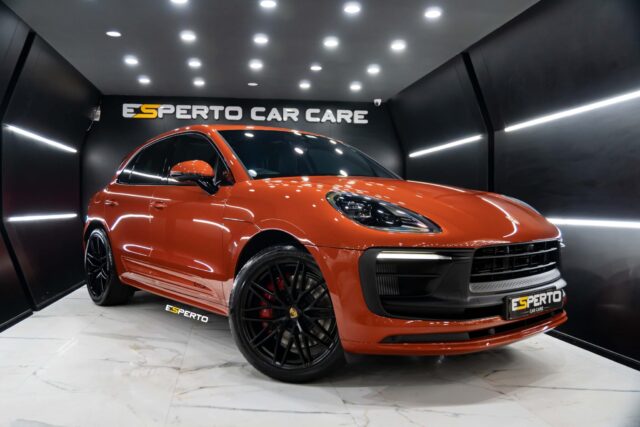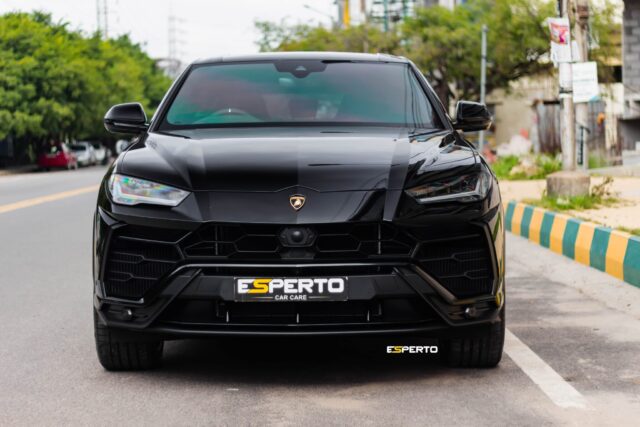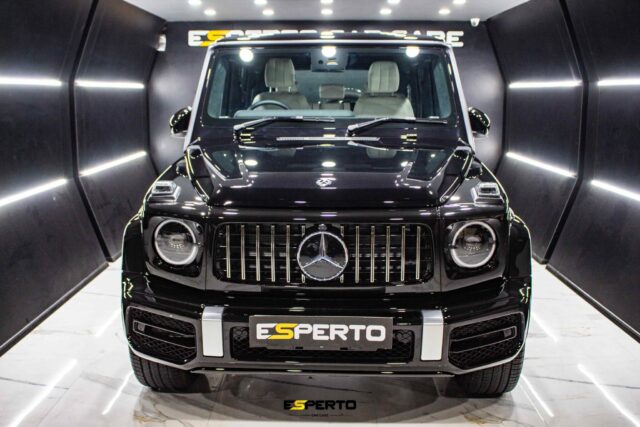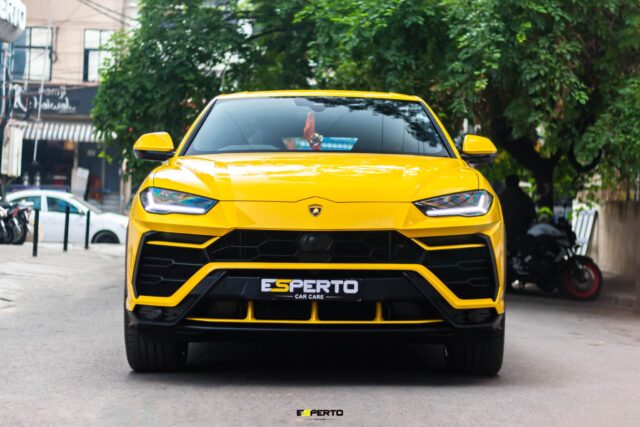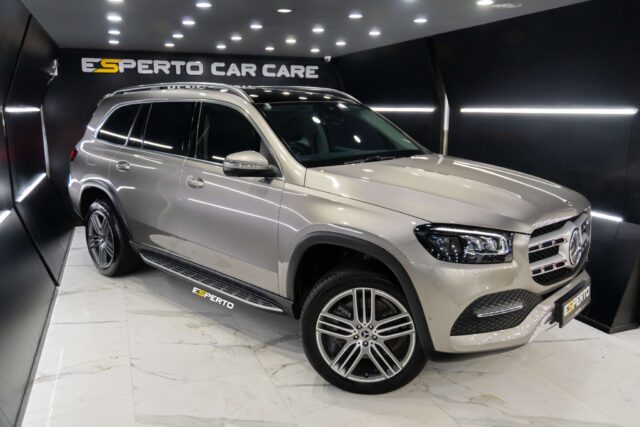Ultimate Guide to Paint Protection Film (PPF): How It Shields Your Car’s Paint and Preserves Its Pristine Look
Every car owner knows how frustrating it can be to find a new scratch on their car’s paint. Whether it’s from road debris, bird droppings, or simply the wear and tear of daily use, keeping your vehicle’s paint pristine is a constant battle.
This is where the best Paint Protection Film (PPF) comes in. But what is PPF for cars? PPF’s best paint protection film offers a robust layer of protection that shields your car’s body paint from damage and keeps your vehicle looking as good as new.
Interestingly, PPF was initially developed for military use to protect helicopter rotor blades during the Vietnam War. Today, this high-quality protective film serves as a guard against scratches, stone chips, UV rays, and other forms of environmental damage.
Looking for reliable PPF in Coimbatore? This blog dives into how Esperto Car Care’s paint protection film can safeguard your vehicle, preserving its original shine and colour for years to come. Read on to see how protecting your car today ensures it stays looking new tomorrow.
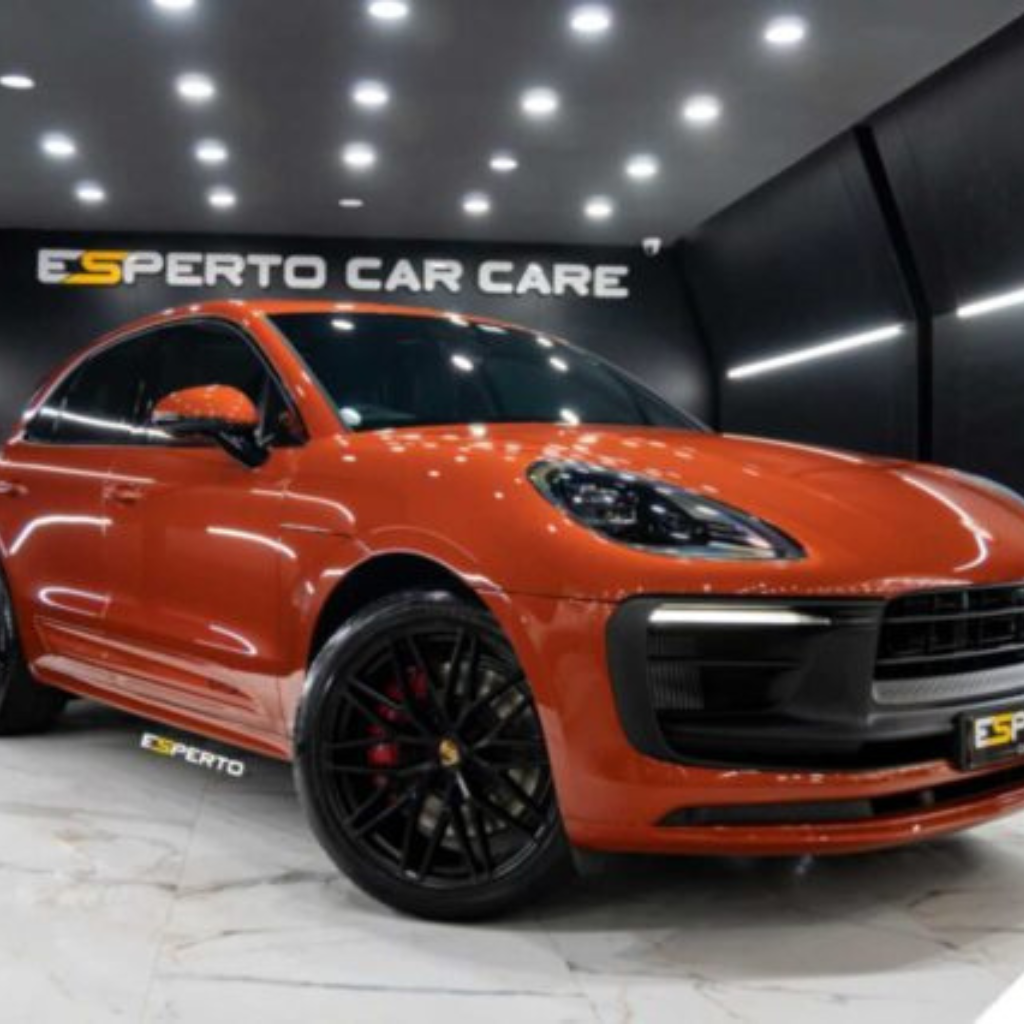
What is PPF and How Does It Work?
Paint Protection Film (PPF) is a transparent film applied to a car’s painted surfaces to shield the paint from scratches, rock chips, and environmental contaminants. This innovative material bonds with the vehicle’s exterior surface, creating an invisible barrier that protects the paint from damage caused by everyday wear and tear.
The high-quality PPF acts as a defensive layer that maintains the car looking new without altering its original colour. PPF provides superior protection for your vehicle’s paint against harsh elements.
Manufacturers design PPF with multiple layers, each serving a specific purpose in protecting the car’s bodywork. The top layer typically has self-healing properties, meaning minor scratches and swirls can disappear with heat exposure from the sun or hot water.
Underneath the middle layer of this ceramic coating, there’s a clear coat that adds scratch resistance and durability to the film. The next layer contains an adhesive that securely bonds with the paint without damaging it when removed or replaced.
Finally, at its core, PPF shields the paint by absorbing impacts from road debris and minimizing harm from UV radiation and chemical stains. This multi-layered approach ensures your vehicle remains pristine while preserving its resale value over time.
What is Paint Protection Film (PPF)?
Paint Protection Film (PPF) is a transparent, durable film applied over your car’s paint to shield it from scratches, rock chips, and environmental contaminants. This film work serves as an invisible barrier that helps keep your vehicle looking new by protecting against damage from the sun’s UV rays, bird droppings, and tree sap.
Car owners value PPF for its self-healing properties; minor scratches can disappear with heat exposure from the sun or engine warmth.
Installing PPF on a car means securing long-term protection for the vehicle’s paint. The process involves carefully applying a clear or tinted film directly onto the car’s body paint.
This protective layer acts significantly to protect your car’s paint from various forms of wear and tear encountered during regular driving. With proper care, this investment in PPF can maintain your car’s aesthetic appeal and resale value for years to come.
How Does PPF Work to Protect Car Paint?
Paint Protection Film (PPF) protects your car’s paint from damage. This thin, clear car paintwork protection film bonds with the vehicle’s paint surface to create an invisible barrier. It’s especially beneficial for the front end and headlights, which are most exposed to daily wear.
It guards against scratches, rock chips, and other forms of physical harm that can occur during everyday use. PPF also shields against harmful UV rays and prevents corrosion, helping to maintain your vehicle’s original shine. This makes new car paint protection film a smart choice right after purchase.
The self-healing properties of paint protection film on cars play a crucial role in preserving its aesthetics. When subjected to heat, minor scratches and swirls in the film disappear, keeping your vehicle looking new. If needed, the film can be easily removed without damaging the paint.
Though there may be drawbacks, such as cost or the need for professional application, the comprehensive guide to what is PPF in cars highlights how it offers long-term benefits. Installing PPF is truly an investment in preserving your car’s beauty and resale value—without altering its original look.
What Are the Layers of Protection in PPF?
Paint Protection Film (PPF) offers multiple layers of paint protection films to shield your vehicle’s paint from scratches, UV damage, and environmental pollutants. The topmost layer is the clear coat, which provides the protected vehicle’s exterior surface with a glossy finish and resists staining.
Beneath this, a special elastic polymer layer allows the film to self-heal minor scratches when exposed to heat. At its core, PPF has an adhesive layer that bonds securely with your car’s paint, providing durable protection without damaging the underlying surface.
PPF acts as a guardian for your car’s exterior, offering resilience against everyday wear while keeping it looking pristine.
This configuration of ceramic coatings ensures overall protection of the car ppf from potential damages such as rock chips and bird droppings. With advancements in technology, modern car PPF also includes UV inhibitors within these layers to protect the paint from fading due to sun exposure.
Offering a solid defence system against various threats, PPF helps maintain your car’s resale value by keeping its paint job intact and shining like new.
Why Should You Install PPF on Your Car?
Installing PPF on your car offers unmatched protection for your vehicle’s paint from scratches, chips, and environmental elements. This layer acts as a barrier against road debris, UV rays, and minor abrasions that can tarnish the look and value of your car.
With its self-healing properties, the film maintains a pristine appearance by erasing swirl marks and light scratches when exposed to heat.
Choosing to apply paint protection film means investing in your car’s longevity and aesthetics. The cost of PPF installation pays off by preserving your vehicle’s paint condition and enhancing its resale value over time.
For car owners who want to keep their cars looking new without constant touch-ups or repaints, PPF provides a practical solution that protects against everyday wear while maintaining the original shine of the paintwork.
Importance of PPF for Car Paint Protection
PPF plays a vital role in shielding your vehicle against various forms of harm. This delicate, transparent film protects the paint from scratches, chips, and stains resulting from road debris, environmental pollutants, and severe weather.
By creating a safeguard over the entire car’s painted surface, PPF sustains the unspoiled state of your vehicle’s paint. It preserves the appearance and also increases the resilience of the vehicle’s paintwork.
Introducing PPF to your car is a wise decision for anyone wishing to safeguard their property. It helps retain your car’s fresh look for extended periods and can considerably lower maintenance expenses associated with paint restoration.
Further, this layer amplifies UV protection on painted surfaces, discouraging paint fading and discolouration due to prolonged exposure to sunlight. With these advantages, installing Paint Protection Film provides a sense of assurance regarding the preservation of your vehicle’s aesthetics and worth.
Now that we have grasped its significance let’s examine the benefits of this type of protection.
What are the Benefits of Paint Protection Film?
Paint protection film (PPF) offers many benefits for car owners, making it a valuable investment for any vehicle. Whether buying new or used, applying car body paint protection film helps shield the paint from scratches, rock chips, and damage vehicles commonly face on the road.
This transparent layer—known in the industry by the PPF abbreviation car—acts as a barrier between your vehicle’s finish and harsh elements like bird droppings, tree sap, and UV rays, which can fade paint over time. PPF automotive solutions help you enjoy a well-maintained exterior, even in the harshest conditions.
One of the standout features of high-quality PPF is its self-healing ability. Light scratches on the film vanish with exposure to heat, reducing the need for constant professional maintenance. With proper care, PPF can last up to 10 years, offering long lasting protection.
Another benefit is peace of mind—car owners can wash their vehicles regularly without risking damage to the underlying paint. According to a car detailing PPF expert at Esperto Car Care Coimbatore, “PPF ensures our vehicles stand up to wear and tear far better than untreated paint.”
If you’re wondering, what does PPF cover? It’s tailored to meet individual needs, from full-body coverage to key areas most prone to damage. In the long run, investing in PPF preserves your car’s resale value and appearance.
To learn more about the contents and benefits of PPF, consult a trusted installer for the right fit for your vehicle.
How PPF Protects Your Car’s Body Paint from Damage?
Moving from understanding the benefits, it’s crucial to explore how PPF on a car works to shield your vehicle’s paint. This luxury car film acts as an aegis against everyday threats like insects, bird droppings, UV rays, and even minor damage from high impact collisions or road debris.
The right PPF offers several advantages, including self-healing properties that allow minor scratches to disappear with warm water, sunlight, or engine heat. This keeps your car looking fresh without damaging the paint. Even side view mirrors and edges are protected from wear.
Despite some cons, such as potential PPF damage from improper application, the benefits far outweigh the drawbacks. When applied with a water solution by experts, PPF exceeds expectations, providing long-lasting shine and resistance to fading.
In short, PPF is a wise choice not just for cars but bikes, too—delivering a strong return on investment while preserving appearance under constant exposure.
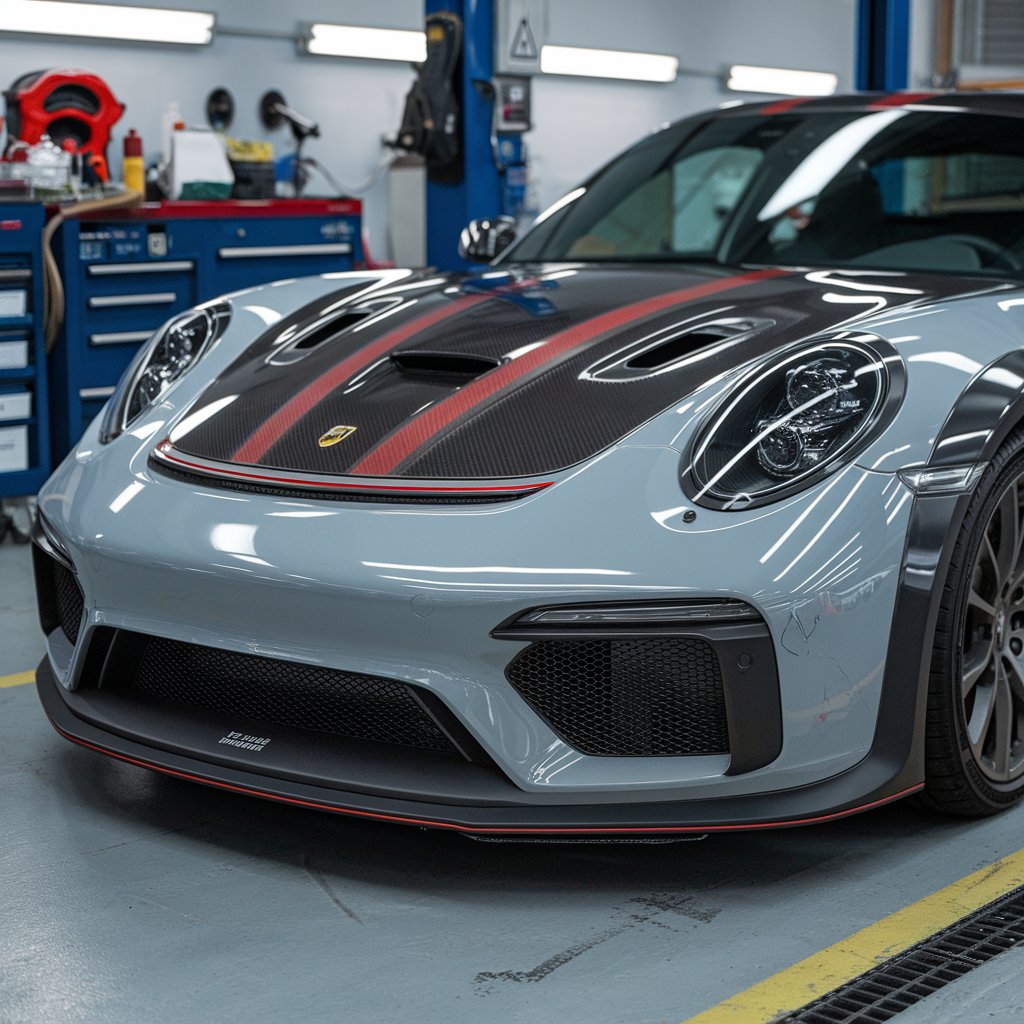
Types of PPF Available
The types of PPF available cater to different needs and preferences. You can choose from clear or tinted options, each designed to protect your vehicle’s paint without damaging it.
Clear PPF is virtually invisible, preserving the original colour of your car while providing superior protection from scratches and environmental damage. Tinted PPF adds a touch of style, enhancing the aesthetics of a protected vehicle with a subtle shade while still offering strong paint protection.
High-quality PPF products have self-healing properties that mend minor scratches when exposed to heat, ensuring the film remains intact for longer periods. When selecting a type of PPF film for your car, consider factors like durability, clarity, and resistance to yellowing over time.
The best PPF brand in India offers a wide range of products that bond securely with the paint to provide a lasting shield against rock chips and other forms of paint damage. Choose wisely to keep your car looking pristine for years.
What are the Different Types of Paint Protection Film?
Choosing the proper paint protection film (PPF) for your car is a crucial decision. It shields your vehicle from scratches, rock chips, and environmental damage. Here’s a look at the different types of PPF available to protect your vehicle’s paint and maintain its aesthetic appeal.
- Clear Paint Protection Film: This type is transparent, allowing the original paint colour to shine through while protecting the paint from various damages. It’s popular among car owners who want to preserve their vehicle’s original look.
- Matte Finish PPF: Designed for cars with a matte paint job or for those looking to change their vehicle’s gloss finish to matte. Matte finish PPF provides the same level of protection as clear PPF but gives the car’s body a stylish, frosted look.
- Coloured or Tinted PPF: Some car enthusiasts prefer adding a bit of personality with coloured or tinted PPF. While it offers the same protective qualities, it also allows you to alter your car’s appearance without permanent changes.
- Self-Healing PPF: Featuring advanced technology, self-healing PPF can repair minor scratches and swirl marks on its own when exposed to heat, keeping your car’s surface looking pristine.
- Ceramic Coated PPF: Combining the benefits of paint protection film and ceramic coating, this type offers superior protection against contaminants and gives your car an impressive glossy finish that is easy to clean.
- Instant Healing PPF: This newer form heals at room temperature much faster than traditional self-healing films do. It provides excellent protection against scratching and scuffing.
- Textured Finish PPF for Specific Parts: Designed specifically for high-impact areas like rocker panels, this type protects against chips and abrasions caused by gravel and road debris on these vulnerable parts of your vehicle.
Each type of paint protection film offers unique benefits. Whether you seek scratch protection, instant healing properties, or aesthetic changes like matte finishes or tinted colours, there’s a product that meets your needs while ensuring your car looks great for years to come.
Clear vs. Tinted PPF: Which is Better?
Transitioning from the various types of car Paint Protection Film (PPF), it’s essential to understand the differences and benefits of clear versus clear or tinted film PPF. This comparison is crucial for car owners, car enthusiasts, and bike lovers who aim to make an informed decision about protecting their vehicle’s car paint protection film upfront.
| Feature | Clear PPF | Tinted PPF |
| Appearance | Preserves original paint color. | Offers a customized look with a range of tint shades. |
| Protection Level | High-level protection against scratches, chips, and environmental damages. | Similar protection to clear PPF with added UV ray protection due to tint. |
| Cost | Generally more affordable than tinted options. | Can be more expensive due to the added benefits of UV protection and aesthetic value. |
| UV Protection | Blocks harmful UV rays but not as effectively as tinted versions. | Enhanced UV ray protection, reducing the risk of paint fade over time. |
| Installation | Installation process is straightforward. | Installation might require more precision due to the tint. |
| Visibility | High visibility, maintaining the car’s original look. | Reduces glare and increases privacy but can decrease visibility slightly. |
Both clear and tinted PPF serves the primary function of protecting the car’s paint from damage. The choice between them depends on the car owner’s preferences for appearance, cost, and added features such as enhanced UV protection and privacy offered by tinted PPF.
High-Quality PPF Products: What to Look For?
Selecting the right car paint protection film (PPF) requires understanding what makes a product high-quality. High-quality PPF products effectively protect your vehicle’s paint from damage.
- Thickness and Material Composition: The best paint protection films are thick enough to guard against rock chips, scratches, and contaminants without altering the car’s appearance. Look for PPF that combines polyurethane films with an elastomeric polymer top layer, which helps it maintain its shape and heal scratches when exposed to heat.
- Clarity: High-quality PPF should be completely transparent, ensuring that it doesn’t diminish the shine or colour of your car paint. Avoid films that appear yellowish or cloudy, as they can affect the look of your vehicle.
- Self-Healing Properties: Premium PPF includes self-healing layers that repair minor abrasions and scratches caused by heat exposure, such as sunlight or hot water. This feature keeps your car looking fresher for longer.
- Hydrophobic Characteristics: Look for PPF with hydrophobic properties, meaning it repels water. This characteristic helps keep the car clean as water beads up and rolls off the surface, carrying dirt and grime with it.
- Durability and Warranty: Top-notch PPF should last at least five years, but many high-quality options offer ten years of protection or more. Check if the product comes with a warranty that covers yellowing, cracking, peeling, staining, and hazing.
- Ease of Installation and Removal: A good paint protection film should allow for straightforward installation by professionals without damaging the paint during application or removal. This ensures that you can change or remove it easily when necessary without leaving residue on the car’s surface.
- Compatibility with Car Washes: Ensure the PPF you choose withstands regular washing without lifting at the edges or losing its protective qualities. High-quality films are designed to resist damage from chemicals found in most car wash soaps.
- Stain Resistance: Premium PPF is beneficial because it can resist stains from bird droppings, bug splatter, tree sap, and other environmental pollutants that might otherwise etch into the car paint.
- Find out if you can apply ceramic coatings to PDFs. Many car owners prefer to apply a ceramic coating to their PDFs for extra glossiness and hydrophobic benefits.
Identifying these characteristics will guide you in choosing a high-quality protective film that preserves your vehicle’s aesthetic appeal while shielding its exterior from wear and tear.
How Much Does PPF Cost?
The expense of a PPF coating application fluctuates significantly due to multiple factors. A complete full vehicle coverage whole car PPF coating price may oscillate between $1,500 to well over $7,000. This broad span depends on the car’s dimensions, the calibre of the film applied, and if the preference is partial or whole car coverage.
Premium protective films with self-repairing properties are usually located on the upper scale.
Aspects like the installer’s proficiency and geographical location also contribute heavily to final and paint protection film installation costs. For example, professional applications in prominent cities may have a higher price than in smaller localities because of increased operational costs.
Simultaneously, choosing supplementary services like ceramic coating over PPF could raise the total expenditure for car owners seeking superior paint protection.
What is the Cost of PPF Installation?
Applying Paint Protection Film (PPF) is a smart investment for maintaining your car’s appearance and resale value. While not all PPFs are the same, high-quality options offer flexibility, long-term protection, and durability against rain, rock chips, and scratches.
The cost varies based on a number of things—car size, availability of materials, type of PPF, and whether you choose full or partial coverage. Full wraps typically range from $1,500 to $5,000. This recommended expense is especially useful for leasing situations or preserving fresh paint.
The combination of a reputable brand and experienced installer like Esperto Car Care Coimbatore ensures a professional job. Over the months, maintenance may involve re-install damaged areas. Though a lot of people try DIY, expert help is advised for the best results.
In addition, PPF provides important protection in high-exposed areas, making it a worthwhile upgrade for any vehicle.
Factors Affecting Paint Protection Film Cost
Understanding the cost of paint protection film (PPF) installation is critical for car owners and enthusiasts. Several factors crucially affect the final price to install paint protection film.
- Size and type of vehicle: Bigger vehicles like SUVs require more PPF, leading to increased costs compared to smaller vehicles.
- Quality of the film: Top-tier protective films with self-healing properties have a higher price tag.
- Coverage area: Applying PPF on the whole car is pricier than partial coverage, such as for front bumpers and hoods.
- Brand of PPF: Various brands have different prices based on their standing and the technology used in the film.
- Professional installation versus DIY: Opting for professional installation guarantees quality but is pricier than doing it yourself.
- Service provider location: Costs can differ significantly depending on the region due to labour rates and market demand variations.
- Condition of the car’s paint: Vehicles necessitating paint correction before the PPF application will have extra charges.
- Warranty offered: Films with a more extended warranty period usually have a higher upfront cost but offer better long-term value.
These factors impact the total cost car owners need to evaluate when shielding their vehicle with paint protection film (PPF). It’s essential to analyze these factors carefully to make a well-informed choice that suits your needs and budget.
Is PPF Worth the Investment for Car Owners?
Utilizing Paint Protection Film (PPF) for your automobile could serve as a prudent financial choice and contribute to the car’s sustained polished look. Applied to a vehicle’s exterior, PPF acts as a thin layer of defence, offering long-lasting protection for highly exposed areas such as fenders, doors, and bumpers. It reduces paint damage from scuffs, stone chips, and exposure to harsh weather conditions or pollutants while maintaining your car’s shine and often a high gloss finish.
As such, vehicles fitted with PPF tend to have an elevated resale value due to their exteriors exhibiting less wear. The top coat of the PPF is typically resistant to minor abrasions and can self-heal, making it superior to vinyl wraps when it comes to preservation and usage longevity.
Although the initial expenditure for PPF installation may appear steep, understanding its long-term rewards can validate it as an intelligent decision. The film’s self-repairing properties help minor scuffs vanish, minimizing the need for frequent paint jobs and protecting against interior deterioration in related zones.
PPF application is suitable for those who value maintaining their vehicle’s speed and appearance or plan to sell it in the future. Ultimately, it’s a wise investment for anyone looking to preserve their car’s condition, aesthetics, and market value.
How to Install PPF on Your Car?
Installing Paint Protection Film (PPF) on your new or used car can protect the paint from scratches, rock chips, and various other damages. This transparent film preserves your new or used car’s aesthetic appeal while offering a high level of scratch protection, too. Here’s how you can apply PPF to your vehicle:
- Clean your car thoroughly. Wash your car regularly to remove dirt, dust, and contaminants from the surface. A clean surface ensures better adhesion of the PPF.
- Dry the vehicle completely. Make sure no water remains on the car’s surface to avoid interference with the PPF application.
- Measure and cut the PPF. This step is crucial for a seamless fit. Use precise measurements of your car’s panels to cut the PPF accordingly.
- Prepare the application solution. Mix a few drops of baby shampoo with water in a spray bottle. This solution helps in positioning the film on the car’s paint.
- Apply the solution to your car’s surface and the adhesive side of the film. The slip solution allows you to move and adjust the movie quickly.
- Place the PPF on the targeted area carefully. Start from one end, applying gentle pressure as you go to avoid air bubbles under the film.
- Use a squeegee to remove air bubbles and excess water under the PPF. For best results, work from the centre outwards in smooth motions.
- Trim any excess material carefully with a sharp blade for edges that match perfectly with your car’s contours.
- Dry and set the film gently over your car’s body using a heat gun or hair dryer until it adheres firmly to your car’s body.
- Allow PPF time to cure fully before washing or waxing your vehicle; this might take up to 48 hours, depending on weather conditions.
This process protects your entire car or specific parts like bumpers and hoods. It mirrors against damage without altering its appearance, acting as an excellent investment for any car owner looking for lasting protection. Maintaining your car’s PPF is an essential next step after installation.
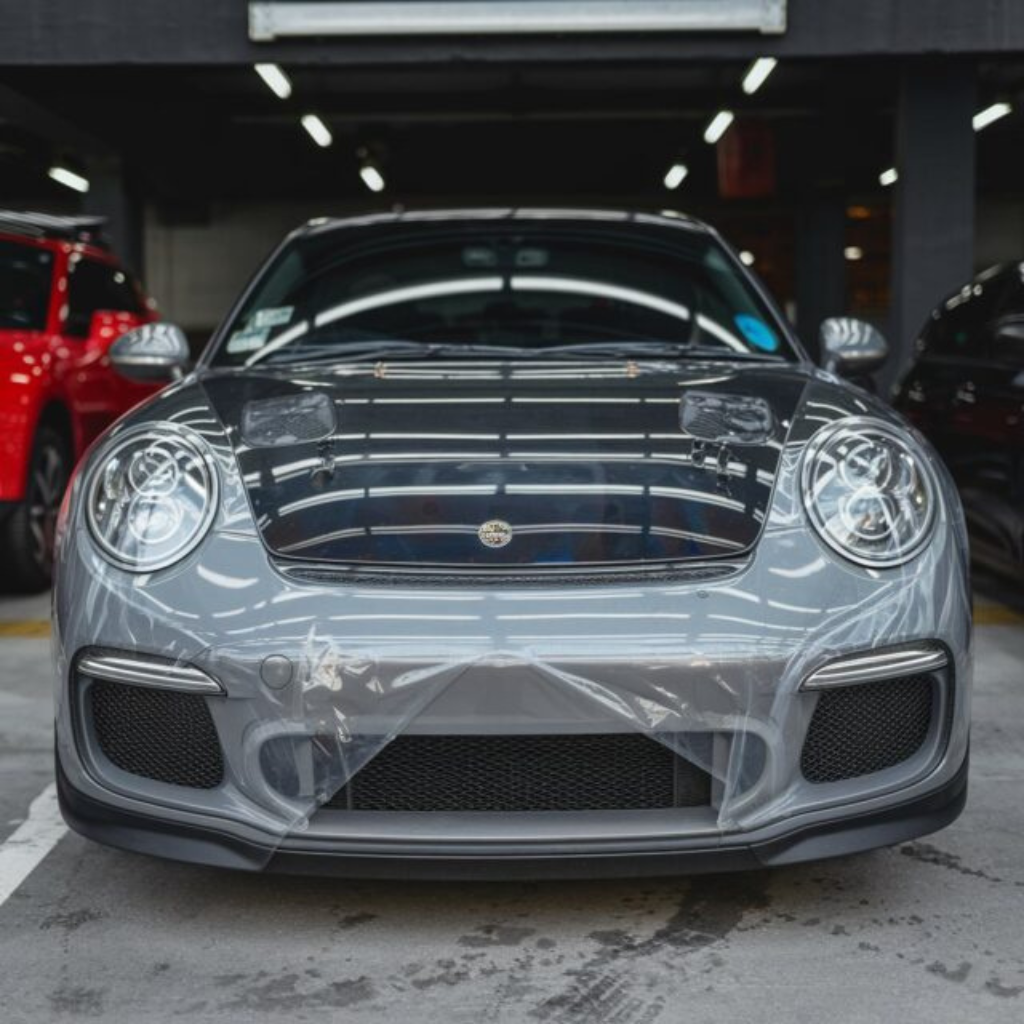
Step-by-step Guide to PPF Installation
Installing paint protection film (PPF) on your car ensures its paint remains unblemished from environmental threats and daily wear. This guide walks you through the PPF installation process, making it easy for car enthusiasts to install paint protection film and protect their vehicle’s aesthetics.
- Clean your car thoroughly. Every inch of the surface where the PPF will be applied must be free of dirt, grease, and wax.
- Dry the vehicle completely. Any moisture can interfere with the adhesion of the paint protection film.
- Measure and cut the PPF according to your car’s dimensions. Precision is crucial here to ensure full coverage without excess.
- Prepare the application solution. Mix water with a few drops of baby shampoo in a spray bottle; this helps in positioning the film.
- Spray the solution onto the car’s surface. This step helps adjust the PPF once it’s on the vehicle.
- Remove the backing paper from PPF and apply it to your car. Start from one end, using a squeegee to smooth out bubbles and wrinkles as you go.
- Use a heat gun carefully to stretch and fit the PPF around curves or edges for perfect alignment.
- Trim any excess material with precision, ensuring that all edges are perfectly sealed against your vehicle’s body.
- Allow the PPF to dry and cure fully, which can take several hours or overnight, depending on environmental conditions.
Following these steps helps create a high-quality protective barrier over your car’s paint, safeguarding it against rock chips, scratches, and contaminants that threaten its finish over time. Proper installation ensures longevity and preserves your vehicle’s aesthetic appeal, making PPF an excellent investment for any car owner looking to maintain their vehicle’s appearance in top condition.
Professional vs. DIY PPF Installation: Which is Better?
After exploring the step-by-step guide to PPF installation, it’s crucial to decide whether to go the professional route or opt for DIY when applying the installed paint protection film. This decision impacts not just the quality of the job but also the longevity and effectiveness of the installed paint protection film.
| Aspect | Professional Installation | DIY Installation |
| Quality of Work | High, as professionals have the experience and skills. | Varies, based on individual skill level and experience. |
| Cost | Higher upfront cost but includes warranty and peace of mind. | Lower initial cost, but lacks professional warranty. |
| Time Investment | None, as the service is outsourced. | High, as it requires significant personal time and effort. |
| Risk of Error | Low, professionals are equipped to handle complex installations. | High, due to lack of experience and professional tools. |
| Longevity and Performance | Optimal, as professional installation ensures proper application. | Potentially lower, improper installation can affect performance. |
| Tools and Equipment | Top-grade tools and materials used. | May require investment in tools and materials. |
| Aftercare Support | Usually provided, offering advice and solutions for any issues. | Self-reliant, must research and solve potential problems independently. |
Choosing between professional and DIY installation of PPF hinges on priorities like budget, time, and desired outcome quality. The professional installation stands out for its assurance of quality and durability, making it a favoured choice for those prioritizing long-term protection and aesthetics of their vehicle.
Maintaining Your Car’s PPF
Taking care of your car’s paint protection film (PPF) extends its life and keeps it looking new. Whether you’ve chosen matte PPF, gloss PPF, or even coloured PPF, regular care is essential. You should wash the PPF-coated vehicle regularly using mild soap and water to maintain the factory paint underneath and preserve the film’s exceptional clarity.
Avoid harsh chemicals or abrasive cleaners and tools that could damage the thin film. For tougher stains, a specialized PPF cleaner is beneficial, especially for surfaces like door handles, door edges, and side mirrors, helping ensure the self-healing top coat remains intact and effective.
To protect your investment further, storing the car properly is key. If possible, park it in a garage or under cover to reduce UV exposure and limit damage from high temperature resistance demands. This not only helps preserve the PPF’s appearance but also offers superior UV protection for your vehicle.
Consulting a professional car detailing expert or a professional car technician periodically can help identify wear early. In some cases, coverage for damage may also be discussed under your car insurance policy, especially if PPF was applied to safeguard the paint. With routine care, your highly durable paint protection film continues to shield your vehicle from daily hazards effectively.
How to Care for Your Car’s Paint Protection Film?
Caring for your car’s paint protection film (PPF) ensures it continues to protect your car paint from damage. Regular maintenance can extend the life of the PPF and keep your vehicle looking new.
- Wash your car regularly to remove dirt and contaminants. Use a mild, automotive-specific soap.
- Apply gentle pressure while washing. Avoid using harsh brushes or sponges that can scratch the PPF.
- Rinse your car with clean water thoroughly to avoid soap residue build-up on the film.
- Dry your vehicle with a soft, microfiber towel to prevent water spots on the PPF.
- Use a specialized PPF cleaner for stubborn stains instead of aggressive chemicals that can damage the film.
- Schedule an annual professional inspection to ensure the PPF is in good condition and hasn’t been lifted or peeled.
- Repair any edges that lift by carefully applying heat with a hairdryer and pressing them back in place.
- Avoid waxing over the PPF since some waxes contain solvents that can degrade the film’s appearance.
- Park in shaded areas as much as possible because prolonged exposure to sunlight can cause PPF to age prematurely.
- Immediately remove bird droppings, tree sap, and other acidic substances that can stain or etch into the film if left untreated.
Regular care keeps your car’s paint protection film effective in shielding it from environmental damage and maintaining its aesthetic appeal for years to come.
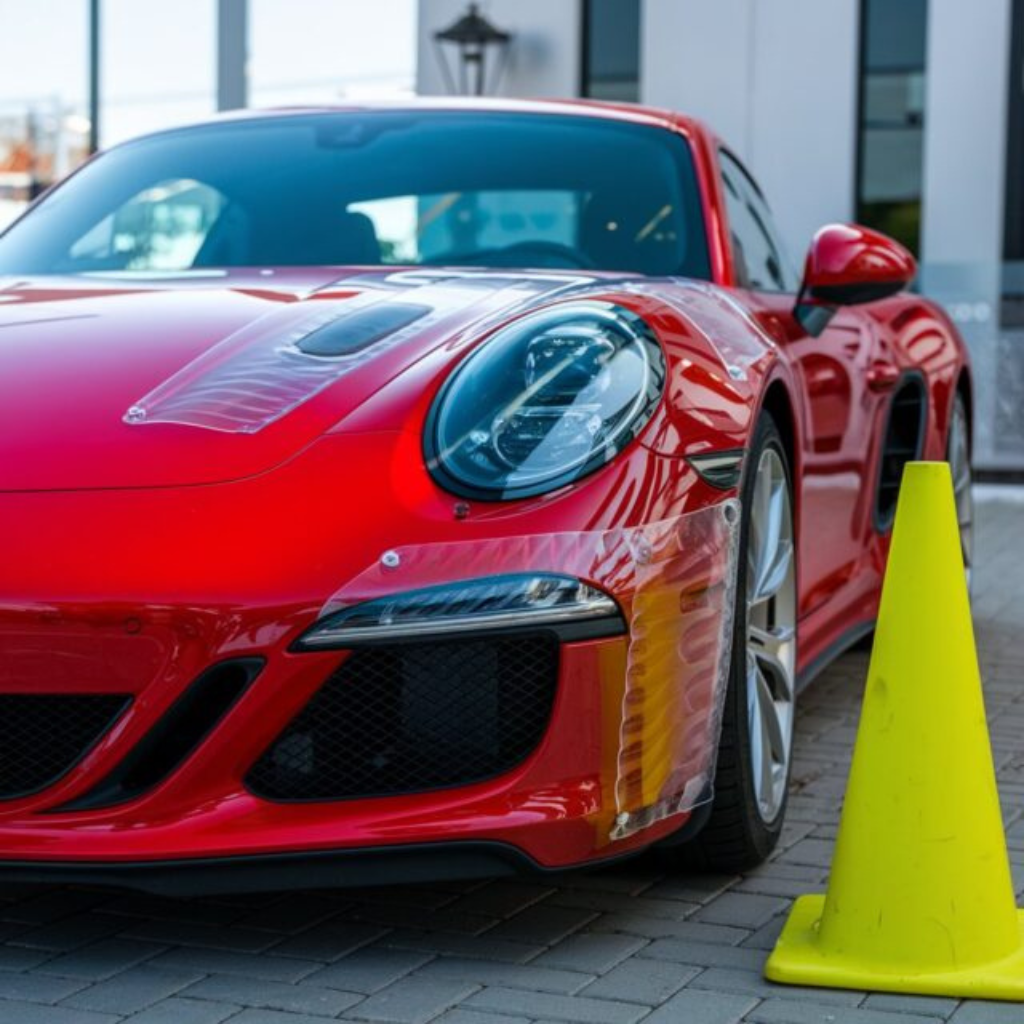
Tips to Keep Your PPF in Top Condition
Preserving your car’s Paint Protection Film (PPF) in optimal condition maintains its shiny appearance and extends the film’s lifespan. Proper maintenance ensures the effectiveness of your PPF in shielding your car’s body paint from harm. Here are some helpful tips:
- Regularly clean your vehicle. If not promptly cleaned off, dirt and debris can result in scratches on the PPF surface.
- Opt for a mild, auto-specific soap. Harsh chemicals can weaken the PPF’s adhesive bond, causing it to peel off.
- For stubborn stains, use a light, non-abrasive cleaner. Always conduct a test on a small section first.
- Use a smooth, clean microfiber towel to dry your car, preventing scratches.
- Avoid direct high-pressure washing on the PPF edges to inhibit lifting or peeling.
- Where feasible, park your car in the shadows. Extended exposure to sunlight can degrade even premium protective films over time.
- If you choose to install the paint protection film yourself, ensure there are no air bubbles or wrinkles that can store dirt.
- You might consider using a ceramic coating above the PPF for added protection from contaminants and UV rays.
- Arrange for annual professional reviews of your PPF to detect and resolve any potential issues early.
- Remove any bird droppings, tree sap, or road tar quickly, as these substances can stain or etch the film surface if not acted upon immediately.
- For some PPF films’ self-healing features, mild heat application with a heat gun or hot water can automatically rectify minor scratches and swirl marks.
- Adhere to the manufacturer’s recommendations for care and maintenance specific to your kind of PPF film.
These steps can ensure your Paint Protection Film remains in excellent condition, preserving your car’s fresh appearance while offering a maximum shield against external damages.
Common Mistakes to Avoid When Maintaining PPF
Preserving your car’s paint protection film (PPF) is vital for its ongoing effectiveness in shielding your vehicle. Many vehicle owners discount the need for correct maintenance, resulting in needless paint damage and expenses.
- Not cleaning consistently: Dust and grit can gather on the PPF’s exterior, potentially creating scratches and dimming the film’s transparency. Regularly clean your PPF with gentle soap and water.
- Employing harsh chemicals: Stay away from cleaners with powerful solvents or alcohol. These substances can degrade the adhesive characteristics of the PPF, leading it to peel or discolour.
- Not using wax or sealant: Some might assume that PPF obviates the requirement for wax or sealants, but the application of these products can add a protective layer against UV rays and dust.
- Overlooking corners and seams: Dust frequently gathers around the corners and seams of PPF, resulting in lifting or peeling. Be extra vigilant about these spots when cleaning.
- Applying intense pressure during washing: High-pressure washers can elevate the PPF edges if used very close. Always maintain a safe gap when employing a pressure washer on your car.
- Repeated exposure of PPF to excessive heat: Prolonged exposure to extreme temperatures can deform or distort PPF over time. Whenever feasible, park in areas with shades or use a car cover.
- Installing PPF on your own without prior experience: PPF installation needs accuracy and proficiency. An improperly installed film might look unattractive and may fail to deliver sufficient protection.
- Not considering self-healing characteristics: Some PPF versions come with self-healing traits that trigger heat. Expose your car to the sun periodically, or use a heat gun for slight scratches.
- Ignoring warranty details: Understand your PPF’s warranty details concerning coverage and maintenance prerequisites to prevent unintentionally invalidating it.
Appropriate maintenance extends the durability of new car paint and protection films remarkably, ensuring they persist in safeguarding new car paint protection films from stone chips, scratches, and environmental damage as intended.
Conclusion
Opting for paint protection film (PPF) installation on your car is a savvy move for any car owner, enthusiast, or bike lover. The PPF on car meaning refers to a thin, durable layer that serves as a barrier between your car’s paint and the elements. The PPF abbreviation car stands for Paint Protection Film—a reliable solution that shields your vehicle from standard threats like rock chips and environmental harm.
Its capability to self-repair assures that your car retains its immaculate state, delivering an enhanced finish while improving its appearance and potential resale value over time. There are a variety of PPF car options to pick from, such as clear or tinted films, allowing you to choose the one that matches your model, colour, and preferences.
While professional installation is often recommended for optimal results, it may be cheaper to apply it yourself if you’re confident in your skills. Still, note that proper tools and conditions are essential. Whether you’re interested in a sleek upgrade or long-term protection, maintaining your PPF requires minimal effort.


